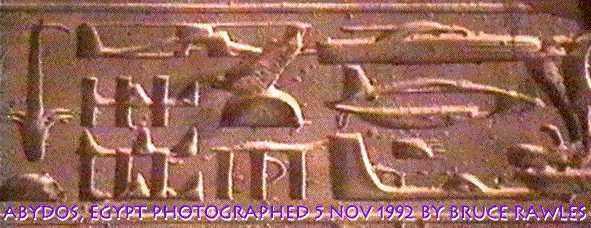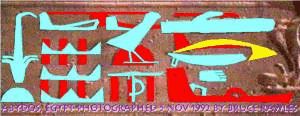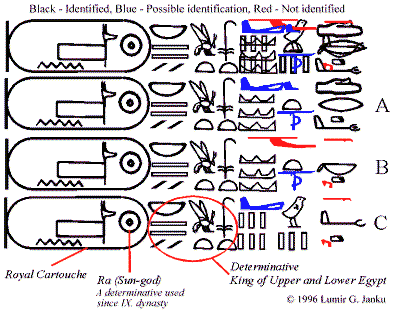
Photography © 1992 Bruce Rawles
The Abydos Mystery

Photography © 1992 Bruce Rawles
Is this for real? Yes the picture is authentic. No post-production manipulations (with an exception of the line added by the author) or tweaking by graphic manipulation software.
The question is: "What do you see?"
Some people have suggested that in the upper left is a shape reminiscent of a helicopter or cessna type of airplane; in the upper right it may be a boat or a submarine; below that may be a UFO or a disc shaped type of airplane; continuing further below might be a track of a bigfoot (or even a Roswell type of alien--four fingers!) and at the bottom the whole glyph seems to end with a jet airplane.
It is my personal opinion that the textbook type of history is not exactly in sync with numerous finds and hints in the ancient literature and core of myths. According to these sources, in the remote past there have been people flying in all sorts of devices, going under the water in submersibles, you name it. Sumerian and Indian literature is quite stunning with its descriptions of many devices, going sometimes into great detail, especially in the Indian epics. Traces of awareness of similar devices are apparent in Greek mythology, or in much earlier Hittite literature, but also in the modern remnants of ancient mythologies, as in the myths of Australian or New Guinean aborigines, American Natives, myths of European nations, Yakuts -- simply wherever you look.
Or, as some suggest, the apparent linearity of the flow of time is an illusion. It may as well be...
But is it true in this case? Do we see either evidence of some highly technologically advanced culture (relatively speaking, from our point of view), or is some sort of time anomaly grinning at us from the Egyptian glyph?
There may be quite a mundane explanation at hand, although it involves a little bit of knowledge about the Egyptian culture, its writing system and the well known tendency to "correct" (alter) previous inscriptions whenever a monarch desired to do so. Plaster mixed with a pigment to match the stone color was an ideal material for modifications. It is just a chain of coincidences that the Abydos samples carry an uncanny resemblance to modern transportation devices, though Jungian thinkers may claim that there is no such a thing as that much sheer coincidence. Maybe the Abydos inscription is, on some deeper level, a type of message hinting at the uncertainty of our perception of time, with a meaning we are only able to discern in an archetypal or other sense. But I would rather leave the philosophical aspects of the inscription alone for now and try to make sense of it by conventional means.
 The first thing which attracts attention of someone who has studied Egyptian literature, at least to a degree which enables one to decipher single hieroglyphs and the meaning of some combinations, are the two leftmost symbols. The two letters are a part of a standard determinative. These two letters mean "king". On a snapshot taken by Sheri Nakken (although it is not a very clear image), additional glyphs are discernable-the determinative for Lower and Upper Egypt and another determinative followed by a royal cartouche. The picture I was supplied (courtesy Amargi) for use in deciphering the name in the cartouche was a low-resolution image, thus the deciphering of the king's name is not guaranteed, but it seems to belong to Senworsets. The first symbol in the cartouche was in use since IX dynasty by all kings, and means Ra (the Sun-god). From these glyphs it is fairly obvious that the whole series of glyph is one of the standard laudatory epithets, possibly describing the loftiness of the king.
The first thing which attracts attention of someone who has studied Egyptian literature, at least to a degree which enables one to decipher single hieroglyphs and the meaning of some combinations, are the two leftmost symbols. The two letters are a part of a standard determinative. These two letters mean "king". On a snapshot taken by Sheri Nakken (although it is not a very clear image), additional glyphs are discernable-the determinative for Lower and Upper Egypt and another determinative followed by a royal cartouche. The picture I was supplied (courtesy Amargi) for use in deciphering the name in the cartouche was a low-resolution image, thus the deciphering of the king's name is not guaranteed, but it seems to belong to Senworsets. The first symbol in the cartouche was in use since IX dynasty by all kings, and means Ra (the Sun-god). From these glyphs it is fairly obvious that the whole series of glyph is one of the standard laudatory epithets, possibly describing the loftiness of the king.
 Not
being trained in the "Khemt" language, the deciphering of the meaning of the glyphs is not possible without help from an Egyptologist. What I did was to identify the glyphs, trying to match the components of the overlaid glyphs with standard hieroglyphs, as seen in the image on the left. Most of the characters are decipherable easily; there are only a few which are obscured by corrections to such a degree that the identification is not possible without a knowledge of the semantic sense of the inscription..The part of the glyph on the right side of the original image is unclear. Unfortunately, a part of the stone on which the glyph was made developed a crack and a small piece of it fell off. The symbol is vaguely familiar; possibly I have seen it used on some other inscriptions in the Abydos complex. I tried to compare it with about 4,800 hieroglyphs in my library, but I was unable to find a close match.
Not
being trained in the "Khemt" language, the deciphering of the meaning of the glyphs is not possible without help from an Egyptologist. What I did was to identify the glyphs, trying to match the components of the overlaid glyphs with standard hieroglyphs, as seen in the image on the left. Most of the characters are decipherable easily; there are only a few which are obscured by corrections to such a degree that the identification is not possible without a knowledge of the semantic sense of the inscription..The part of the glyph on the right side of the original image is unclear. Unfortunately, a part of the stone on which the glyph was made developed a crack and a small piece of it fell off. The symbol is vaguely familiar; possibly I have seen it used on some other inscriptions in the Abydos complex. I tried to compare it with about 4,800 hieroglyphs in my library, but I was unable to find a close match.
There is one aspect of the inscription which is puzzling. The temple in Abydos (or Abdjou, as the location was called by Egyptians), is quite a remarkable edifice, especially as far as the quality of glyphs is concerned. They are all very precise and as far as I can judge, there's no trace of sloppy workmanship anywhere in the temple, bare the above inscription. The temple was build by Seti I and finished by his son, Ramses II, during an era of classical revival. The obvious corrections on the inscription in question are thus seemingly out of place. But without the translation of the inscription, it is difficult to propose a hypothesis for why the original inscription was changed, apparently twice.
We can conclude that the inscription is not a record of ancient knowledge of machines similar to our modern transportation devices. The seemingly modern pictographs are a coincidental combination of quite common symbols.
Are there other artifacts or records that would suggest the opposite? To answer that question, we have to look at numerous enigmatic objects and inscriptions. These are usually interpreted by archeologists in the same way they explain away practically anything which does not fit into preconceived notions about the knowledge base of ancient cultures -- as mere "religious symbolism." A new look, and a new outlook, may provide future insight into the past.
Text and Illustrations ©1996 Lumir G. Janku
Photography courtesy of Bruce Rawles
The Modern Past
Airplanes
Batteries and Electric Devices
Skulls from Ica, Peru and Merida, Mexico